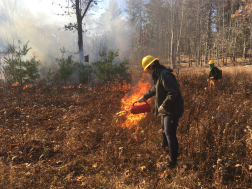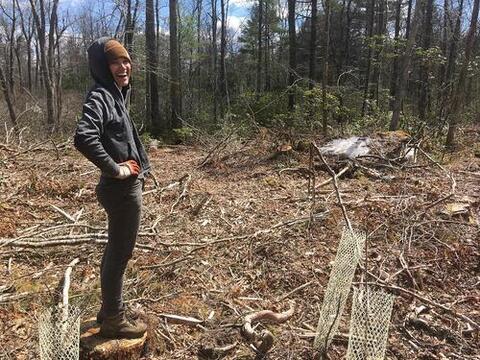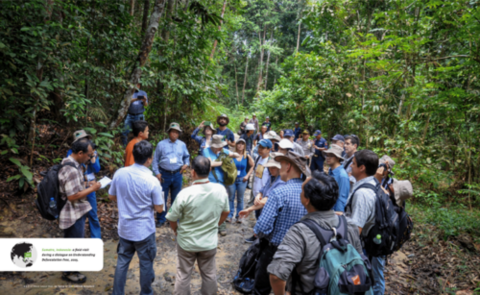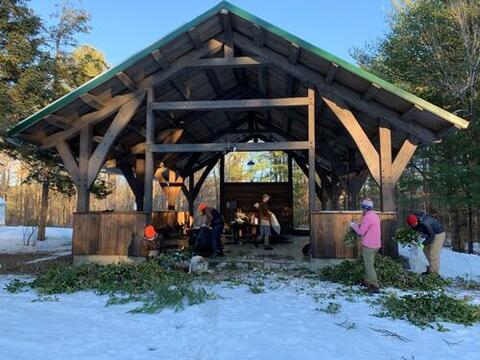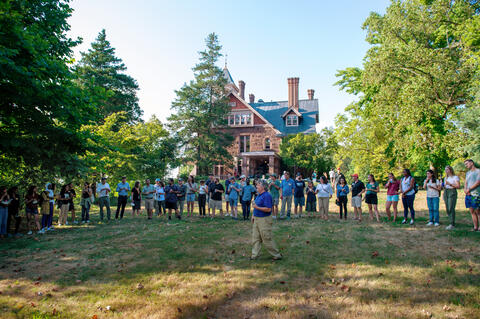
The Creation of a Sub-school and Plan
After the school’s name change and creation of The Forest School at the Yale School of the Environment in 2020, we got to work. This transition created a natural moment of reflection and planning – where do we want to go in the next decade? What changes do we want to see in our school, community, and profession?
We embarked on answering these questions by composing The Forest School’s mission and vision as our guide. Two years after their debut, we are happy to launch our strategic plan (link is external). The plan, covering activities from 2020-2030, embodies forest-specific goals and strategies at the school and folds directly into YSE’s 2017 strategic plan.
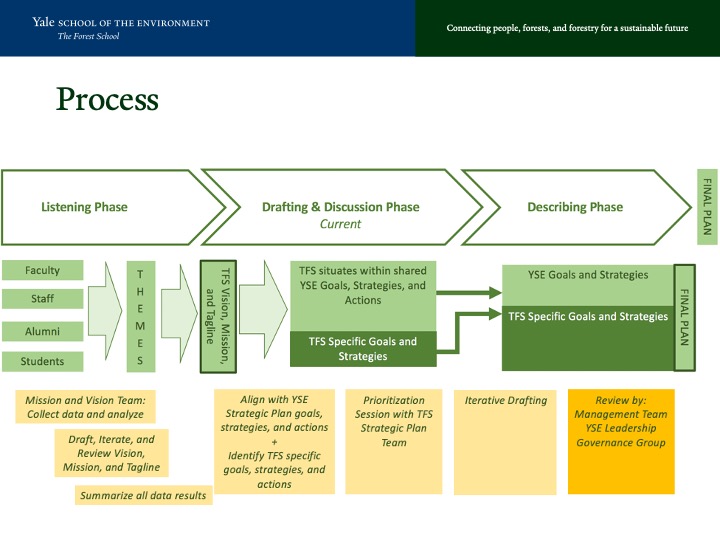
The Forest School’s strategic plan is a co-created document — relying on the input of faculty, staff, students, and alums — composed through a listening, drafting and discussing, and describing phases. Source: Liz Felker
An Iterative, Inclusive Process
To create The Forest School’s strategic plan (link is external), we drew upon our community. The writing process of the strategic plan was broken into three main phases: listening; drafting and discussing; and describing. It was in this listening phase — which also led to the creation of TFS’ mission and vision statements — that we conducted 40 interviews and 300 surveys of alums, surveyed 35 master’s and doctoral students, and interviewed key faculty, while the Poorvu Center for Teaching and Learning (link is external) held focus groups for staff.
We identified core themes from this vast data to draft goals, strategies, and actions specific to The Forest School, while also finding alignment with YSE’s 2017 strategic plan. Using The Forests Dialogue’s engagement methods, we held workshops with forestry-related faculty and staff to prioritize and organize the goals and strategies. From there, the core TFS team initiated the describing phase through iterative drafting. The resulting plan — shaped by faculty, forestry Centers and Programs, staff, students, alums, the Office of the Dean, and the Office of Communications — will now guide us through this decade of our collective work for forests, forestry, and people.
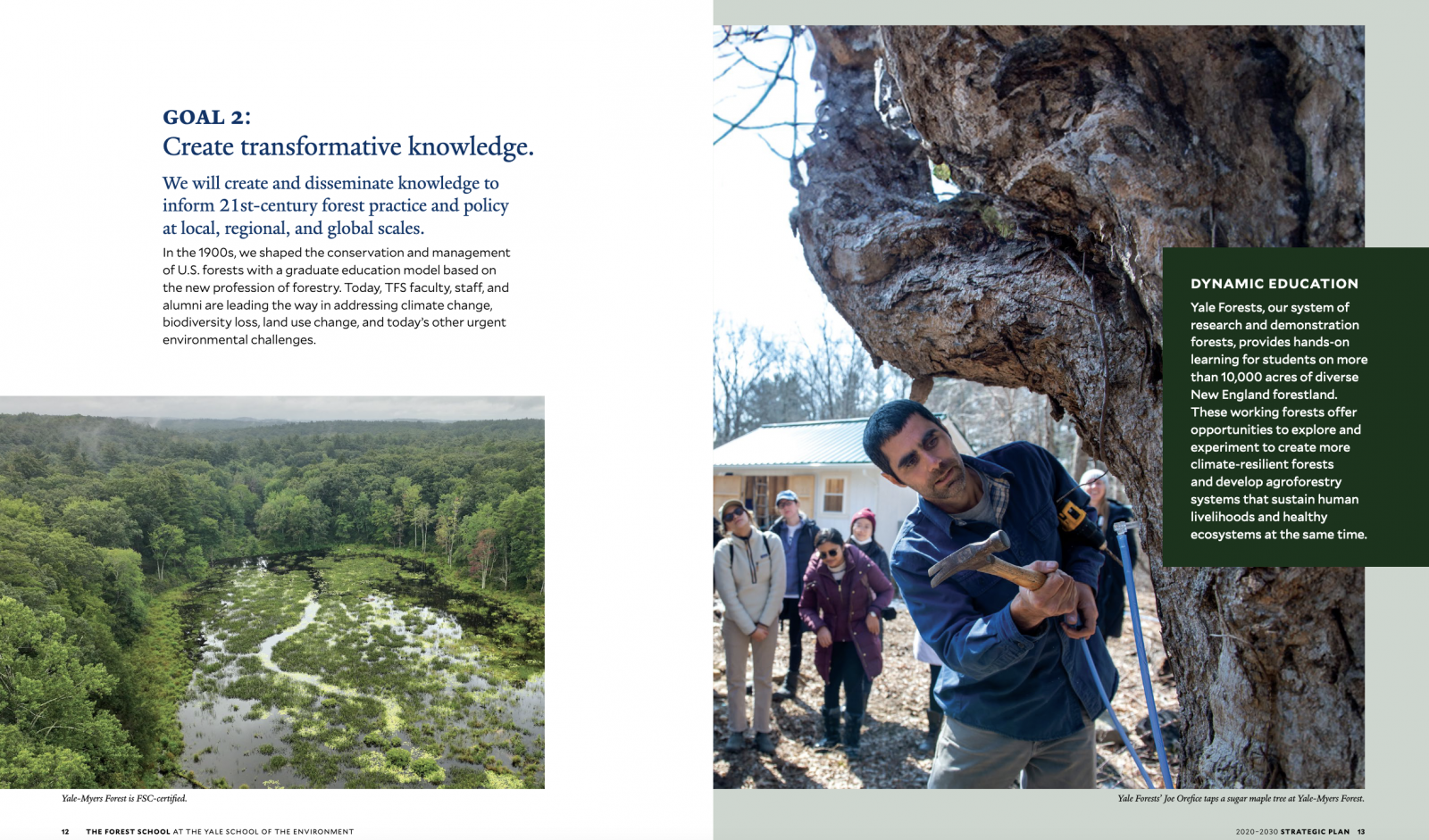
The strategic plan not only contains our goals, strategies, and actions, but highlights the people who are part of enacting them and the places where we learn, teach, and research.
Goals, Strategies, and Actions Galore
The plan outlines 10 goals, 14 strategies, and over 80 actions. The goals are organized under three themes: 1) Deepen Our Impact, 2) Strengthen Our Community, and 3) Enhance Our Function. Our impact goals focus on how we learn, teach, and create knowledge. Our community goals are dedicated to creating and advancing a culture of belonging; cultivating respectful, reciprocal relationships; and engaging our network. Finally, the goals organized under our function relate to our place within the Yale School of the Environment, our broader leadership role, and cultivating financial support for our work.
While our goals are broad, our strategies provide direct pathways to reach them. The 14 strategies are interconnected, and many have the benefit of addressing multiple goals at the same time, creating strength and synergy. The strategies range from: clarifying our role as a “school within a school” to cultivating reciprocal relationships, especially with Indigenous, disempowered, and underrepresented peoples to strengthening our place-based research, education, and practice to expanding our role as a convener to increasing the dissemination of our research to support practitioners and policymakers.
For each strategy, we have developed lists of actions and sub-actions to effectively implement the plan. Within the public-facing document, we list a couple of indicative actions for each strategy. Internally, we have a robust list of over 80 actions and sub-actions that pave the way forward, many of which are already complete or in progress.
Moving Toward Our Goals
We consider the strategic plan to be a living, breathing document. While we were compiling the public-facing document, the plan itself was already in motion. Over the past couple of years, we have taken concrete steps to move toward our goals. We have created The Forest School’s management team of faculty and staff; launched the TFS and Yale Forest Forum websites; collaborated with the Yale Center for Environmental Justice and Salish Kootenai College to create a Tribal forestry series and exchange; co-created the Yale Applied Science Synthesis Program; and are strategically engaging and participating in broader forestry networks like the Society of American Foresters (SAF) and the International Union for Forest Research Organizations (IUFRO).
We invite you to explore the plan (link is external) and join us as we create a more sustainable Forest School and society. We anticipate reporting out on our progress via YSE’s annual report document, Impacts, and through updates from The Forest School.
If you have any questions, please contact us at forestry@yale.edu (link sends e-mail).
